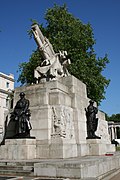Wikipedia talk:Featured article candidates/Royal Artillery Memorial/archive1
HJ Mitchell just to be sure you saw my pre-closing remarks. Congrats! SandyGeorgia (Talk) 00:49, 16 November 2020 (UTC)
- Yes, I saw them, thanks! This is the first time I've logged in on an actual computer since then! A smartphone is fine for checking my watchlist but not so much for fiddling with wikitext! HJ Mitchell | Penny for your thoughts? 20:51, 16 November 2020 (UTC)
- @SandyGeorgia: no reply necessary if you're busy. Just so you know I've considered your points: "over-lifesize" is the term used in the books and "larger" sounds odd to me (like something you'd say in a eulogy, "he was larger than life"); both "subsequently"s gone; it was very much the RAWCF's insistence on realism that the eminent architects struggled with (there's a lot more in the body about classicism vs realism); yes, it's the first use of the word "cross", but it's described as "cruciform" (and linked) in the previous sentence; and while WWI is a widely understood concept, it's one the reader may wish to explore in more detail if they're reading about a memorial commemorating it. All the best, HJ Mitchell | Penny for your thoughts? 21:30, 16 November 2020 (UTC)
- No prob! SandyGeorgia (Talk) 21:33, 16 November 2020 (UTC)
The Royal Artillery Memorial is a First World War memorial in London, England. Designed by Charles Jagger, himself an ex-soldier who had been wounded in the war, with architectural work by Lionel Pearson, the memorial commemorates the 49,076 soldiers from the Royal Artillery killed in the First World War. The static nature of the conflict meant that artillery played a major role in the war. The memorial consists of a Portland stone cruciform base supporting a one-third over-lifesize sculpture of a howitzer (a type of artillery field gun). At the end of each arm of the cross is a sculpture of a soldier, one shown in death. The memorial was unveiled on 18 October 1925. The design was controversial when unveiled, but later came to be recognised as one of Britain's finest war memorials. Dedications were later added in memory of the 29,924 Royal Artillerymen killed in the Second World War. It underwent restoration in 2011 and is a Grade I listed building (Full article...)
981 characters, including spaces
Hi @Hchc2009 and HJ Mitchell: Congratulations. A draft blurb for this article is above. Thoughts, comments and edits from you or from anyone else interested are welcome. Gog the Mild (talk) 13:27, 20 November 2020 (UTC)

